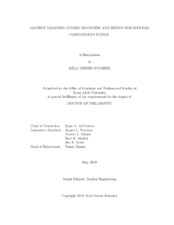| dc.description.abstract | Inertial confinement fusion (ICF) experiments at the National Ignition Facility (NIF) and their corresponding computer simulations produce an immense amount of rich data. However, quantitatively interpreting that data remains a grand challenge. Design spaces are vast, data volumes are large, and the relationship between models and experiments may be uncertain.
We propose using machine learning to aid in the design and understanding of ICF implosions by integrating simulation and experimental data into a common frame-work. We begin by illustrating an early success of this data-driven design approach which resulted in the discovery of a new class of high performing ovoid-shaped implosion simulations. The ovoids achieve robust performance from the generation of zonal flows within the hotspot, revealing physics that had not previously been observed in ICF capsules.
The ovoid discovery also revealed deficiencies in common machine learning algorithms for modeling ICF data. To overcome these inadequacies, we developed a novel algorithm, deep jointly-informed neural networks (DJINN), which enables non-data scientists to quickly train neural networks on their own datasets. DJINN is routinely used for modeling data ICF data and for a variety of other applications (uncertainty quantification; climate, nuclear, and atomic physics data). We demonstrate how DJINN is used to perform parameter inference tasks for NIF data, and how transfer learning with DJINN enables us to create predictive models of direct drive experiments at the Omega laser facility.
Much of this work focuses on scalar or modest-size vector data, however many ICF diagnostics produce a variety of images, spectra, and sequential data. We end with a brief exploration of sequence-to-sequence models for emulating time-dependent multiphysics systems of varying complexity. This is a first step toward incorporating multimodal time-dependent data into our analyses to better constrain our predictive models. | en |


